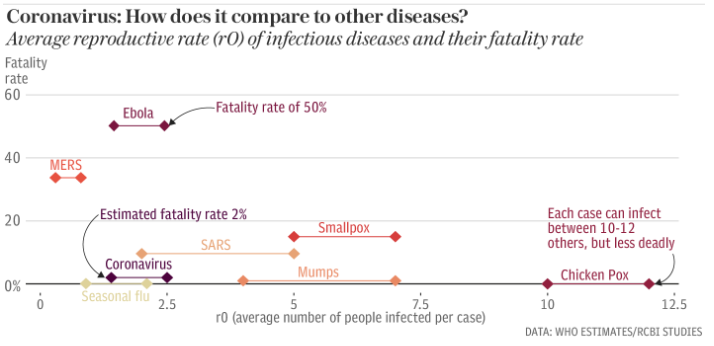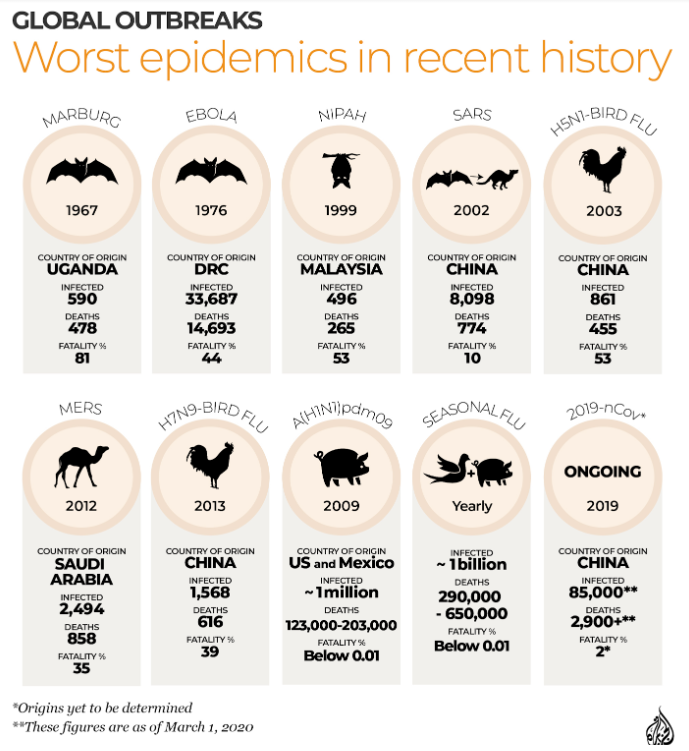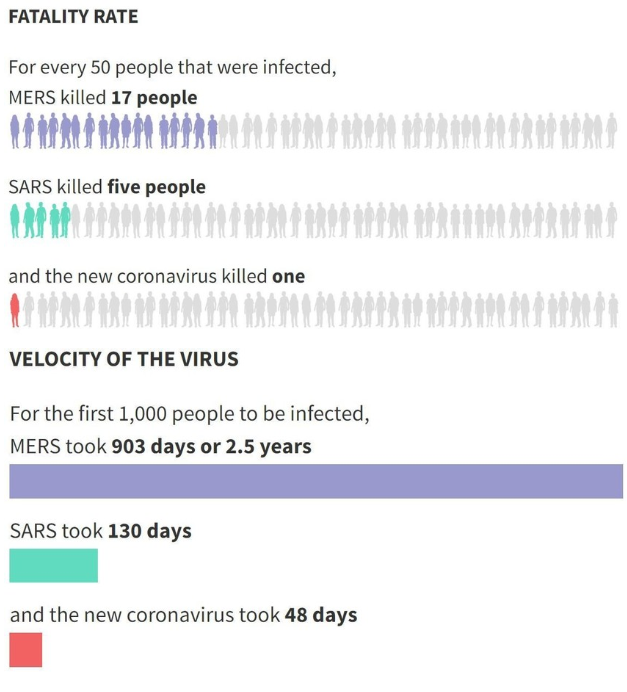
10 Mar Swine Flu, Ebola, Black Death & More: How Coronavirus Stacks Up & What We Should Learn
With the first Coronavirus case reported in South Africa last week we thought it could be worth looking back at the world’s history of viruses and pandemics to see how COVID-19, as it’s officially known, compares. Some speculate it’s here to stay, and will become part of our seasonal illness repertoire to be warded off by way of a future vaccine.
While COVID-19 seems to spread easily, the symptoms tend to be mild, particularly for people who are relatively young and healthy. The SARS and MERS outbreaks, also strains of coronavirus, had significantly higher death rates. As with Ebola, they’re all thought to have originated in bats. Looking back at the world’s history of viruses, it’s fascinating to see the common themes and causes.
DESCENDING CHRONOLOGICALLY, HERE ARE 12 VIRUSES THAT HAVE ROCKED THE WORLD:
COVID-19 (2019 – Present)
DEATH TOLL: 3 800
The virus was first seen in December 2019, when a mysterious illness was reported in Wuhan, China. The near-identical gene sequences of 90 analysed cases from outside of China suggests that it likely emerged after a solitary species jump from an unknown (likely mammal) intermediate host. There has been mention of Pangolins (an endangered ant-eating mammal) being the source as scientists in Guangzhou have shown a coronavirus with 99% homology, with a receptor-binding domain identical to that of SARS-CoV-2. However, this has not been confirmed, and, in addition, the pangolin’s rarity means this may not be the only mammal involved. The reason for the rapid alarm and warning around the Coronavirus is due to its increased incubation period; which is estimated between 5 – 14 days. The virus is passed easily through saliva or mucus carried in the air for up to six feet.
MERS (2012 – Present)
DEATH TOLL: 858
Middle East Respiratory Syndrome (MERS) is a species of coronavirus that originated in bats, spread to camels in the mid-90s and then, in March 2012, infected a human for the first time.
It emerged in Saudi Arabia and took eight years to infect almost 2,500 people with a death rate of about 34%. Of the 27 countries affected globally, 10 countries are in or near the Arabian Peninsula and 17 countries are outside of the Arabian Peninsula. MERS, which still jumps to people from camels, doesn’t pass easily from person to person unless there is close contact like physical touch.
SWINE FLU (2009 – Present)
DEATH TOLL: 284 500+
The 2009 flu pandemic, or swine flu, was the second of the two pandemics involving H1N1 influenza virus (the first of them being the 1918 – 1920 Spanish flu pandemic). The virus appeared to be a new strain of H1N1, which resulted when a previous triple reassortment of bird, swine and human flu viruses further combined with a Eurasian pig flu virus. It’s estimated that 11% – 21% of the then global population (of about 6.8 billion), or around 700 million – 1.4 billion people contracted the illness – more in absolute terms than the Spanish flu pandemic. However, it had a much lower fatality rate.
SARS (2002 – 2003)
DEATH TOLL: 774
Severe acute respiratory syndrome coronavirus (SARS) spread to a number of countries around the world but the virus was snuffed out after about 8 000 cases and nearly 800 deaths. The entire SARS outbreak lasted about six months and was brought to an end by good hygiene practices – such as frequent hand-washing – and environmental factors such as high temperature and humidity in the summer months. About 9% of patients died. When compared to the new virus, the spread of SARS took much longer to gain momentum. No cases of SARS have been reported anywhere in the world since 2004.
HIV/AIDS PANDEMIC (1980s – Present)
DEATH TOLL: 36 Million+
HIV/AIDS is believed to have originated in chimpanzees in West Africa and transferred to humans in the early 20th century. It’s believed that it developed through hunters eating bushmeat. HIV/AIDS grew into a global pandemic, killing more than 36 million people since 1981, when it was first clinically reported.
Currently, there are between 31 and 35 million people living with HIV, the vast majority of those are in Sub-Saharan Africa, where 5% of the population is infected, roughly 21 million people. As awareness has grown, new treatments have been developed that make HIV far more manageable, and many of those infected go on to lead productive lives. Between 2005 – 2012 the annual global deaths from HIV/AIDS dropped from 2.2 million to 1.6 million.
EBOLA (1976 – Present)
DEATH TOLL: 15 000
Ebola was first identified in 1976, in two simultaneous outbreaks: one in a town in South Sudan and another in a town in Democratic Republic of the Congo, near the Ebola River from which the disease takes its name. Fruit bats are believed to be the normal carriers, able to spread the virus without being affected by it. Besides bats, other wild animals sometimes infected with Ebola include several monkey species, chimpanzees, gorillas, baboons and duikers.
Ebola has a high risk of death, with an average of about 50% of those infected. Symptoms include fever, severe headache, muscle pain and weakness, diarrhea, vomiting, bleeding and bruising. Death typically follows 6 to 16 days after symptoms appear. The largest outbreak of Ebola was in West Africa, between 2013 and 2106, which led to 11 323 deaths.
HONG KONG FLU (1968)
DEATH TOLL: 1 Million
The Hong Kong Flu originated in China in July 1968. It was the third pandemic flu outbreak to occur in the 20th century, killing one million people worldwide and about 100 000 people in the US alone.
ASIAN FLU (1957)
DEATH TOLL: 1.1 Million
The Asian Flu began in East Asia in 1957. That specific influenza virus was an H2N2 strain, which was first detected in Singapore in February 1957. From there, the virus made its way to Hong Kong in April 1957, and in coastal cities in the United States in the summer of 1957. An estimated 1.1 million people died of the Asian flu worldwide, with 116 000 of them in the US.
SPANISH FLU (1918 – 1920)
DEATH TOLL: 50 million
The 1918 influenza pandemic, colloquially known as Spanish flu, was unusually deadly. The world was recovering from World War I, that had killed some 20 million people, and suddenly had to contend with something even more deadly: a flu outbreak. Infecting a third of the world’s population in just 18 months, it swiftly killed more people than the Great War itself. The death toll is estimated to have been anywhere from 17 million to 50 million, and possibly as high as 100 million, making it one of the deadliest epidemics in human history. There were no vaccines, nor effective drugs to treat symptoms. Instead, people were instructed to wear masks, wash their hands and avoid crowds – much like today.
Doctors have described the Spanish flu as the “greatest medical holocaust in history”. It was not just the fact it killed so many, it was that so many of its victims were young and healthy. To maintain morale, wartime censors minimised early reports of illness and mortality in Germany, the United Kingdom, France, and the United States. Papers were free to report the epidemic’s effects in neutral Spain. These stories created a false impression of Spain as especially hard hit, giving rise to the pandemic’s nickname, ‘Spanish flu’. But it should also be noted that it was partly due to the censorship that the death toll was so high.
The World Health Organisation estimates that 2% – 3% of those who were infected died. This flu killed more people in 24 weeks than HIV/AIDS killed in 24 years. However, the Black Death killed a much higher percentage of the world’s then smaller population.
SIXTH CHOLERA PANDEMIC (1910 – 1911)
DEATH TOLL: 800 000+
Like it’s five previous incarnations, the Sixth Cholera Pandemic originated in India where it killed over 800 000 people, before spreading to the Middle East, North Africa, Eastern Europe and Russia. The Sixth Cholera Pandemic was also the source of the last American outbreak of Cholera. By 1923, Cholera cases had been cut down dramatically, although it was still a constant in India. In total, cholera pandemics have led to the deaths of almost 40 million people mostly in regions such as China, Russia and India.
BLACK DEATH (1346 – 1353)
DEATH TOLL: 75 – 200 Million
From 1346 – 1353 an outbreak of the bubonic plague ravaged Europe, Africa, and Asia, with an estimated death toll between 75 and 200 million people. Also known as the Pestilence and the Great Plague, Black Death was thought to have originated in the Steppes of Central Asia due to climate change. The plague most likely jumped continents via the fleas living on the rats that frequently lived aboard merchant ships. Ports being major urban centers at the time, were the perfect breeding ground for the rats and fleas, and thus the insidious bacterium flourished, devastating three continents in its wake.
In total, the plague may have reduced the world population from an estimated 475 million to 350 – 375 million in the 14th century. More than 60% of Europe’s entire population died at the time. It took 200 years for Europe’s population to recover to its previous level and some regions like Florence only recovered by the 19th century.
Black Death first emerged as tumours in the groin or armpits, some of which grew as large as an apple. In many cases, black spots appeared on the arm or the thigh or elsewhere. This was followed by acute fever and vomiting of blood. Most victims died two to seven days after initial infection.
The plague repeatedly returned to haunt Europe and the Mediterranean throughout the 14th to 17th centuries and was present somewhere in Europe in every year between 1346 and 1671. An outbreak in 1850 killed over 12 million people. Even today, plague has not been eradicated, with the highest reported cases coming from Madagascar. Although thanks to the availability of vaccination and antibiotics, few people now die of it.
PLAGUE OF JUSTINIAN (541 – 542)
DEATH TOLL: 25 Million
Thought to have killed perhaps half the population of Europe, the Plague of Justinian was an outbreak of the bubonic plague that killed up to 25 million people in its year-long reign of terror. Generally regarded as the first recorded incident of the bubonic plague, the Plague of Justinian left its mark on the world, killing up to a quarter of the population of the Eastern Mediterranean and devastating the city of Constantinople, where at its height it was killing an estimated 5 000 people per day and eventually resulting in the deaths of 40% of the city’s population.
TUBERCULOSIS (Antiquity – Present)
DEATH TOLL: 1 Billion
Tuberculosis (TB) is the number one cause of death from an infectious disease, killing between 1.5 million and 2 million people a year. The WHO estimates that approximately one-quarter of the world’s population is infected, with less than half of all TB cases ever diagnosed. About 80% of people in many Asian and African countries test positive. Research suggests that as many as 1 billion people have lost their lives to TB over the past two centuries.
TB is spread through the air when people who have active TB in their lungs cough, spit, speak, or sneeze. The classic symptoms are a chronic cough with blood-containing mucus, fever, night sweats and weight loss. It was historically called ‘Consumption’ due to the weight loss. Before the Industrial Revolution, folklore often associated tuberculosis with vampires because it sucked the life from those infected.
TB has been present in humans since ancient times. Researchers have found tubercular decay in the skeletal remains of bison from 17 000 years ago and in the spines of Egyptian mummies dating from 3000 to 2400 BC. Hopes of completely eliminating TB ended with the rise of drug-resistant strains in the 1980s.






Dwayne Nzimande
Posted at 15:51h, 17 MarchExcellent, thank you!